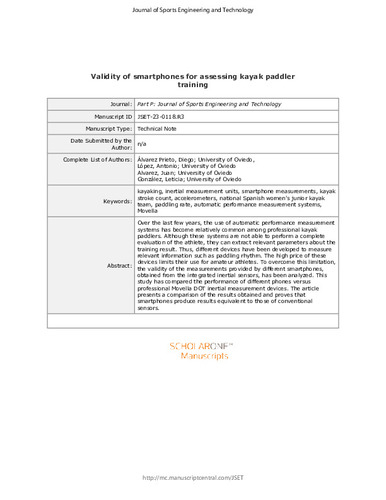Validity of smartphones for assessing kayak paddler training
Palabra(s) clave:
kayaking
inertial measurement units
smartphone measurement
kayak paddle count
Fecha de publicación:
Editorial:
Sage Journals
Versión del editor:
Citación:
Resumen:
Over the last few years, the use of automatic performance measurement systems has become relatively common among professional kayak paddlers. Although these systems are not able to perform a complete evaluation of the athlete, they can extract relevant parameters about the training result. Thus, different devices have been developed to measure relevant information such as paddling rhythm. The high price of these devices limits their use for amateur athletes. To overcome this limitation, Abstract: the validity of the measurements provided by different smartphones, obtained from the integrated inertial sensors, has been analyzed. This study has compared the performance of different phones versus professional Movella DOT inertial measurement devices. The article presents a comparison of the results obtained and proves that smartphones produce results equivalent to those of conventional sensors.
Over the last few years, the use of automatic performance measurement systems has become relatively common among professional kayak paddlers. Although these systems are not able to perform a complete evaluation of the athlete, they can extract relevant parameters about the training result. Thus, different devices have been developed to measure relevant information such as paddling rhythm. The high price of these devices limits their use for amateur athletes. To overcome this limitation, Abstract: the validity of the measurements provided by different smartphones, obtained from the integrated inertial sensors, has been analyzed. This study has compared the performance of different phones versus professional Movella DOT inertial measurement devices. The article presents a comparison of the results obtained and proves that smartphones produce results equivalent to those of conventional sensors.
ISSN:
Patrocinado por:
This research was funded by HUMAN ANALYTICS, S.L., grant number FUO-21-302.
Colecciones
Ficheros en el ítem





